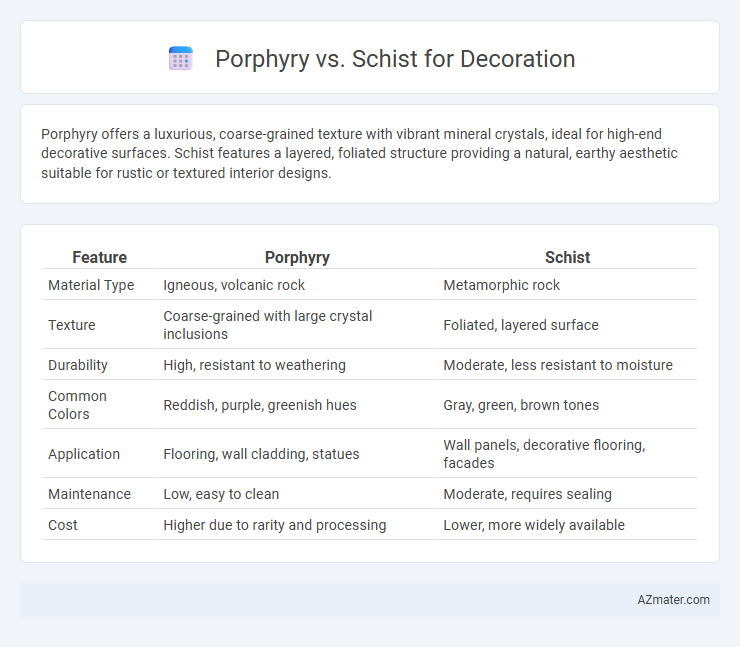Porphyry offers a luxurious, coarse-grained texture with vibrant mineral crystals, ideal for high-end decorative surfaces. Schist features a layered, foliated structure providing a natural, earthy aesthetic suitable for rustic or textured interior designs.
Table of Comparison
| Feature | Porphyry | Schist |
|---|---|---|
| Material Type | Igneous, volcanic rock | Metamorphic rock |
| Texture | Coarse-grained with large crystal inclusions | Foliated, layered surface |
| Durability | High, resistant to weathering | Moderate, less resistant to moisture |
| Common Colors | Reddish, purple, greenish hues | Gray, green, brown tones |
| Application | Flooring, wall cladding, statues | Wall panels, decorative flooring, facades |
| Maintenance | Low, easy to clean | Moderate, requires sealing |
| Cost | Higher due to rarity and processing | Lower, more widely available |
Introduction to Porphyry and Schist
Porphyry is a durable igneous rock characterized by large, visible crystals embedded in a fine-grained matrix, prized for its rich colors and unique textures in decoration. Schist is a metamorphic rock known for its foliated structure and shimmering appearance due to abundant mica minerals, often chosen for decorative walls and flooring. Both stones offer distinct aesthetic and textural qualities that enhance architectural and interior design projects.
Geological Origins of Porphyry and Schist
Porphyry, an igneous rock characterized by large feldspar crystals embedded in a fine-grained matrix, originates from the slow cooling of magma deep within the Earth's crust, leading to its distinctive texture and durability ideal for decorative applications. Schist, a metamorphic rock formed under intense heat and pressure from sedimentary or igneous precursors, displays pronounced foliation due to aligned mica minerals, resulting in a layered appearance valued in decorative stonework. The geological origins of porphyry provide a hardness and polishability that contrast with the schist's flaky, textured surface created through regional metamorphism.
Visual Characteristics: Color and Texture
Porphyry features a distinct visual appeal with large, well-defined feldspar crystals set in a fine-grained matrix, offering a speckled texture that enhances decorative surfaces. Its colors range from deep reds and purples to earthy browns, providing a rich, warm palette ideal for statement pieces. Schist, known for its foliated texture and layered appearance, showcases shimmering mica flakes that create a lustrous surface with colors varying from gray and green to silver and gold, lending a dynamic, natural elegance to interior and exterior designs.
Durability and Strength Comparison
Porphyry exhibits exceptional durability and high compressive strength, making it ideal for heavy-traffic decorative applications and outdoor installations. Schist, characterized by its foliated structure, is generally less durable and more prone to splitting, limiting its use to interior decoration and low-impact surfaces. The superior hardness and weather resistance of porphyry ensure long-lasting performance compared to the more fragile and softer schist.
Suitability for Indoor vs. Outdoor Decoration
Porphyry's durability and resistance to weathering make it highly suitable for outdoor decoration, enduring harsh conditions while maintaining its vibrant colors and texture. Schist, with its layered structure and higher susceptibility to moisture damage, is better suited for indoor decoration where it can provide a unique, natural aesthetic without exposure to the elements. Choosing between porphyry and schist depends on the specific environmental conditions and desired longevity of the decorative surfaces.
Maintenance Requirements for Each Stone
Porphyry demands minimal maintenance due to its dense, hard composition that resists staining and weathering, making it ideal for high-traffic decorative surfaces. Schist, while visually appealing with its foliated texture, requires more frequent sealing and careful cleaning to prevent moisture absorption and damage from abrasion. Regular maintenance of schist involves gentle cleaning with pH-neutral products and periodic resealing to preserve its aesthetic and structural integrity.
Cost and Availability Analysis
Porphyry offers higher durability and unique aesthetic appeal but comes at a premium cost due to its limited quarry sources and labor-intensive extraction process. Schist is more widely available and generally more affordable, making it a cost-effective option for decorative applications without compromising on natural texture and color variety. Evaluating project budgets and regional material supply will help determine the optimal choice between the exclusive luxury of porphyry and the practical accessibility of schist.
Environmental Impact and Sustainability
Porphyry, a durable igneous rock, is prized for its low porosity and long lifespan, reducing the need for frequent replacement and minimizing environmental impact compared to more porous materials like schist. Schist, a metamorphic rock with a foliated texture, may require more energy-intensive quarrying and treatment processes, leading to higher carbon emissions. Choosing porphyry for decoration supports sustainability goals by offering a resilient material with lower maintenance demands and less ecological disturbance over its lifecycle.
Design Applications: Modern and Traditional Uses
Porphyry's coarse-grained texture and rich, vibrant hues make it ideal for bold, modern design applications such as feature walls, flooring, and countertops that demand a statement piece. Schist, with its foliated texture and natural shimmer, complements traditional design aesthetics commonly used in fireplaces, garden paths, and accent walls, adding rustic elegance. Both stones offer durability and unique visual appeal, allowing designers to blend timeless charm with contemporary sophistication in interior and exterior decoration.
Choosing the Right Stone for Your Project
Porphyry offers exceptional durability and unique, vibrant patterns making it ideal for high-traffic decorative applications, while schist provides a softer texture with layered, glittery aesthetics suited for accent walls and interior detailing. Consider porphyry for outdoor projects requiring weather resistance and longevity, whereas schist excels in indoor environments where visual appeal and ease of shaping are priorities. Evaluating the stone's hardness, color variation, and maintenance needs ensures the right choice aligns with both functional demands and design goals.

Infographic: Porphyry vs Schist for Decoration
 azmater.com
azmater.com